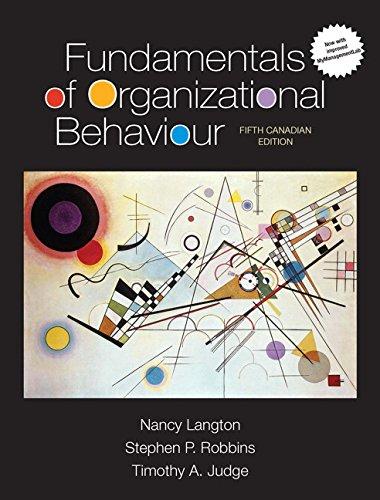Jay Scovie looked at his workspace. He took pride in how nice and tidy he had made
Question:
Jay Scovie looked at his workspace. He took pride in how nice and tidy he had made it look. As it turns out, his pride was misplaced. Sweeping visible clutter from your workspace by packing it into boxes hidden in a closet was not acceptable to his employer, Japanese manufacturer Kyocera. Scovie's habit drew the attention of Dan Brown, Kyocera's newly appointed inspector. "It became a topic of repeated conversation," Scovie said. Why the obsession with order? Kyocera has joined a growing list of organizations that base their culture on 5S, a concept borrowed from lean manufacturing and based on five phases or principles:
1. Sorting (Seiri). Going through all tools, materials, and supplies so as to keep only what is essential.
2. Straightening (Seiton). Arranging tools, supplies, equipment, and parts in a manner that promotes maximum effi ciency. For everything there should be a place, and everything should be in its place.
3. Shining (Seiso). Systematic cleaning to make the workplace and workspace as clean and neat as possible. At the end of the shift or workday, everything is left as it was when the workday started.
4. Standardizing (Seiketsu). Knowing exactly what your responsibilities are to keep the first three S's.
5. Sustaining (Shitsuke). Maintaining and reviewing standards, rigorous review, and inspection to ensure order does not slowly slip back into disorder or chaos. Other companies are following Kyocera in making 5S an important part of their culture, including London, Ontario-based 3M Canada, Markham, Ontario-based Steelcase, and St. Thomas, Ontario-based Waltec. Lawn mower manufacturer Toro organizes printer output according to 5S principles, and Virginia Mason Hospital in Seattle uses 5S to coordinate office space and arrange the placement of medical equipment, such as stethoscopes. Paul Levy, president and CEO of Beth Israel Deaconess Medical Center in Boston, has used 5S to reduce errors and time lost searching for equipment.
At Kyocera, Brown exercises some discretion-he asked one employee to remove a hook on her door while allowing another to keep a whale figurine on her desk. "You have to figure out how to balance being too picky with upholding the purpose of the program," he said. While Brown was happy with Scovie's desk (if not the closet), he wanted to look inside. Scovie tried to redirect the conversation but relented when Brown pressed. Inside one of Scovie's desk drawers was a box full of CDs, small electronic devices, and items Kyocera no longer makes. "Obviously, we're at the sorting stage here," Scovie told Brown.
1. What would you see as the value in Kyocera using 5S?
2. What are some advantages and disadvantages of trying to impose a similar culture in Canadian companies?
3. What might your response be to having to engage in the 5S principles in your workplace?
Step by Step Answer:

Fundamentals Of Organizational Behaviour
ISBN: 9780134204932
5th Canadian Edition
Authors: Nancy Langton, Stephen Robbins, Timothy Judge





